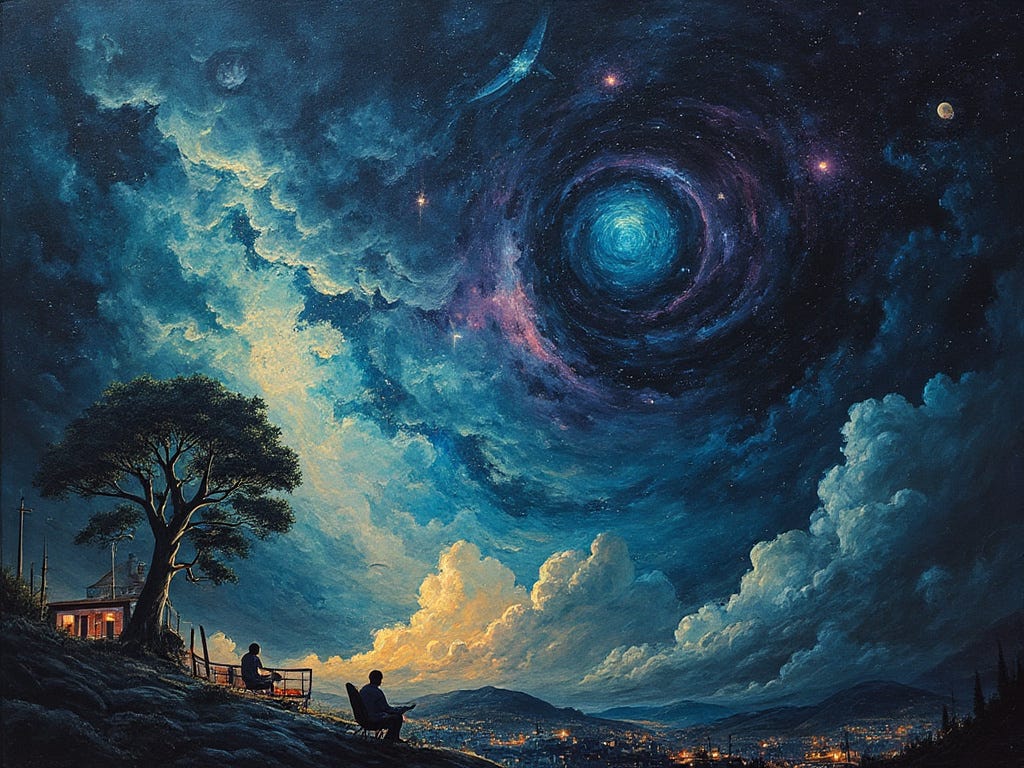Brief Thoughts about Tommy Orange's "Wandering Stars" WARNING SPOILERS* sorta...Native Americans oh Where Art Thou?
Was It All a Dream? If So, Whose Dream Is It?
Tommy Orange uses dreamlike elements and supernatural themes in “There There” and “Wandering Stars” to convey the complexities of Native American identity and memory. In the novels "There There" and "Wandering Stars," Tommy Orange introduces us to a Native American story that is unique and contemporary. Both novels tackled the heavily loaded subject of Native American heritage and all the positive and negative baggage that Native history harbors. It is safe to assume that there was an immense challenge for Tommy Orange to express and compact all of the existential dread, history, and reality that Native Americans have faced and continue to face. One could surmise the artistic ways Tommy Orange constructed these stories, constructing them in a way that is contemporary, universal, and undeniably true to his own Native identity. Reading both novels, we find ourselves as a "settler" audience engaging with Native American content with an inherent bias due to our conscious and subconscious minds being loaded with a "settler's" view of Native American history. Tommy Orange, aware of this loaded content, readily informs us in the prologue of "There There," with the syntax representing a "long-haired Indian depicted, drawn by an unknown artist in 1939, broadcast until the late 1970s to American TVs everywhere after all the shows ran out..." The words that stick out there are "American TV, 1939, broadcast until the late 1970s to American TVs everywhere after all the shows ran out." (Orange, Tommy. There There. Alfred A. Knopf, 2018.) "The shows ran out," emphasizes how narratives about Native Americans that have programmed Americans have come to a point of fatigue. In this sense, Orange seems to be introducing us to a new Native American "show," but not a show or a story about one character in particular. Instead, he may be writing about all Native Americans or, perhaps, in a supernatural way, about none of them at all. The stories he tells feel simultaneously specific to Native heritage and universal but as if they exist in a dreamlike space. For example, "Just now, he is in a dream he doesn't know is a dream, which makes it real, though it weaves him across the years, impossibly, he believes it is real and so it is, but only as true as his belief that he is being followed, a belief that stuck around since the wolf, a belief that follows him in dreams as in life, and worse, sometimes he thinks he is following himself, that all his actions are predetermined, and that he is a kind of shadow, watching himself do everything after the fact, a kind of echo..." (Orange, Tommy. Wandering Stars. Alfred A. Knopf)
The dreamlike language is also linked with addiction, an addiction that affects memory; addiction was a sprinkled trait in some of the characters found in "There There," examples like habitual internet surfing, constant eating, and pot smoking. The theme of addiction mixes with dreams and the supernatural, moving individuals into a delirious state that blurs the lines between sleep (death) and wakefulness (the real world) significantly affecting their cultural memories and perceptions. In "Wandering Stars," Charles Stars uses laudanum; "he cannot tell the difference between his memories, his present, and his dreams…" Tommy writes, "This is the fault of his morphine tincture, the fault of his habit, the fault of the laudanum. He'd taken to calling it his medicine even though he'd long since known it didn't do him any good. Dreams are that way, too. Not necessarily good or bad, just so strange and specific as to feel true..." (Orange, Tommy. Wandering Stars. Alfred A. Knopf) The syntax continues to shine over the supernatural and reality; for example, "He is on the train. Riding that iron horse, almost falling asleep, or just waking up, assuming either way that he definitely isn't dreaming, cut by the grip of the iron chains at his wrists and ankles, the shackles eating away at his skin, there where the metal bites the bone each time the train bounces. The dream is made of his father's memories, from stories his father told him." The scene proceeds to show us Opal, but in an artistic style that differs significantly from "There There." Instead of showing us Opal's thoughts via her dialogue, we learn about her later in "Wandering Stars" here in chapter six, "Over There," it continues, "The dream is made of his father's memories, from stories his father told him in a letter Opal gave him that his father sent to her father, a letter meant for Charles, which reached him at the school and got into his head like a song." (Orange, Tommy. Wandering Stars. Alfred A. Knopf)
There are literary strands, particularly in Wandering Stars, that suggest a dreamlike theme that hints at a supernatural bedrock that underpins the overall structure of both novels. "There There" uses the word "dream," "dreaming," or "dreams" 37 times, while "Wandering Stars" uses it 80 times, more than double. This suggests that "Wandering Stars" might be leaning into a more poetic and supernatural language compared to "There There." This mirage-like quality, woven around the chapters, suggests that the story of the lives of the Native characters is not meant to be taken literally. For example, the importance I placed on Tony Loneman's story, or Opal's story, felt like an ephemeral yearning a longing for the resolution I sought in "There There" to be fulfilled in "Wandering Stars." This desire for closure seemed to come from an unknown place. Frankly, I couldn't quite grasp whose story deserved my emotional attention. At first read, "Wandering Stars" historical approach does not appear to follow the coherent plot structure of "There There." However, Charles Stars’s narrative embodies a dreamlike quality throughout the novel, suggesting to me that Charles is representing more than just Charles. He represents Toney, Opal, Blue, and the out-of-touch Natives. Orange writes, "Charles Star's memories come and go as they please. They are a broken mirror through which he only ever sees himself in pieces. He doesn't know that it is true of everyone, of memory itself, that it is a centerless map and, for those who risk too much looking back at their lives, a trap." (Orange, Tommy. Wandering Stars. Alfred A. Knopf) Still, there is a supernatural, unsettling feeling that permeates both stories; Tony Loneman, as he lies dying, recalls a lesson from his grandmother; in his final moments, "Tony remembers something his grandma said to him when she was teaching him how to dance. "You have to dance like birds sing in the morning, "... "Let the wind sing through the holes in him, listen to the birds singing. Tony isn't going anywhere. And somewhere in there, inside him, where he is, where he'll always be, even now it is morning, and the birds, the birds are singing." (Orange, Tommy. There There. Alfred A. Knopf, 2018.) This ghostly imagery of birds carries over into Wandering Stars, specifically in the first chapter, titled "Young Ghost."
Charles may be a distant spiritual kin to Tony Loneman or perhaps even a continuation of his soul. As Tony's eyelids close in death, the new character awakens from a bad dream, "Wandering Stars" opening scene picks up where Toney died. "I thought I heard birds that morning time just before the morning light, after I shot up, scared of men so white they were blue. I'd been having dreams of blue men with blue breath, and the sound of birds was the slow squeaking of wheels, the rolling of mountain howitzers approaching our camp at dawn. The bad dreams had been coming for weeks..." (Orange, Tommy. Wandering Stars. Alfred A. Knopf,) The imagery of birds is found heavy in the syntax; Tony and the newly introduced character have striking similarities, like a grandmother parlaying in supernatural ideas, the imagery of birds, dreaming, and both being Native Americans; "So I'd taken to sleeping with my grandmother, Spotted Hawk. She'd prayed for me before I closed my eyes to sleep, blew smoke in my face after rolling up some tobacco in a corn husk, then sang me the song that slowed my breath and made my eyelids heavy." (Orange, Tommy. Wandering Stars. Alfred A. Knopf) Let's recall that in the ending of "There, There, Tony's soul was not being destroyed; rather, he was dispersing unto the ethereal shores of time, which fluxes in all temporal directions. "Tony isn't going anywhere. And somewhere in there, inside him, where he is, where he'll always be, even now it is morning, and the birds, the birds are singing". (Orange, Tommy. There There. Alfred A. Knopf, 2018.)
In this analysis, I primarily focused on the supernatural aspects that operate throughout both stories. There is an intricate relationship between memory, addiction, and identity, creating a dreamlike living experience for the Native characters. There are connections between Tony's death and Charles's historical story, as well as between Charles and the wider Native community found in both novels. The poetic language in "Wandering Stars" added depth to the overall reading experience. The novels themselves appear to be like mirages, appearing to be about one thing (the lives of contemporary Native Americans) but revealing something more profound and entirely different.







